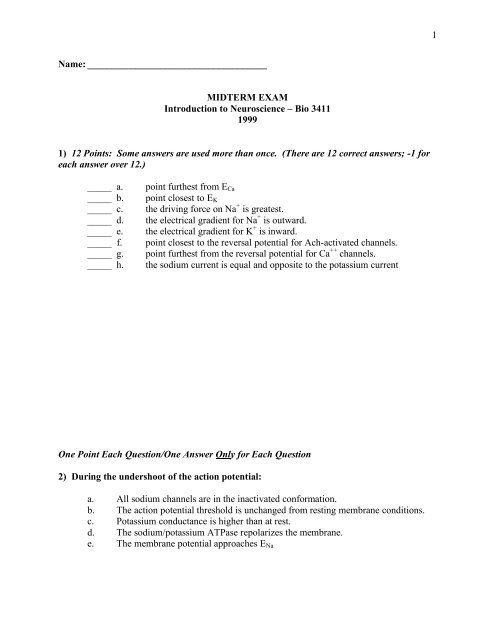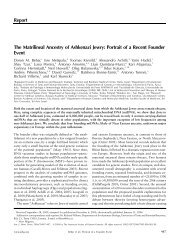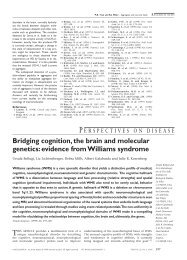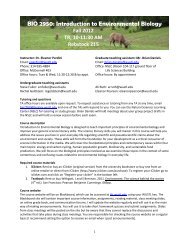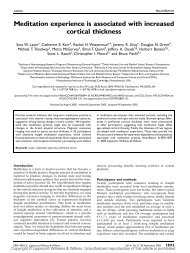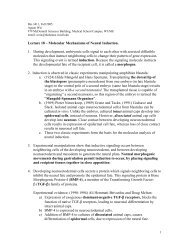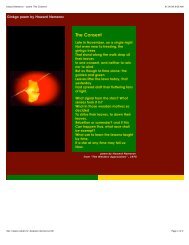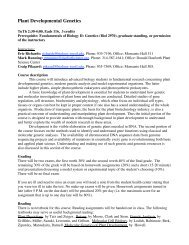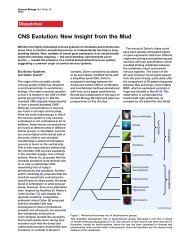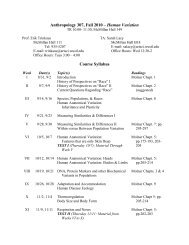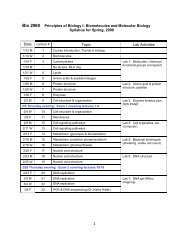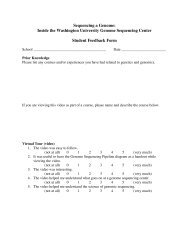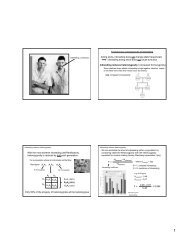MIDTERM EXAM Introduction to Neuroscience â Bio 3411 1999 1 ...
MIDTERM EXAM Introduction to Neuroscience â Bio 3411 1999 1 ...
MIDTERM EXAM Introduction to Neuroscience â Bio 3411 1999 1 ...
Create successful ePaper yourself
Turn your PDF publications into a flip-book with our unique Google optimized e-Paper software.
1<br />
Name: _____________________________________<br />
<strong>MIDTERM</strong> <strong>EXAM</strong><br />
<strong>Introduction</strong> <strong>to</strong> <strong>Neuroscience</strong> – <strong>Bio</strong> <strong>3411</strong><br />
<strong>1999</strong><br />
1) 12 Points: Some answers are used more than once. (There are 12 correct answers; -1 for<br />
each answer over 12.)<br />
_____ a.<br />
_____ b.<br />
_____ c.<br />
_____ d.<br />
_____ e.<br />
_____ f.<br />
_____ g.<br />
_____ h.<br />
point furthest from E Ca<br />
point closest <strong>to</strong> E K<br />
the driving force on Na + is greatest.<br />
the electrical gradient for Na + is outward.<br />
the electrical gradient for K + is inward.<br />
point closest <strong>to</strong> the reversal potential for Ach-activated channels.<br />
point furthest from the reversal potential for Ca ++ channels.<br />
the sodium current is equal and opposite <strong>to</strong> the potassium current<br />
One Point Each Question/One Answer Only for Each Question<br />
2) During the undershoot of the action potential:<br />
a. All sodium channels are in the inactivated conformation.<br />
b. The action potential threshold is unchanged from resting membrane conditions.<br />
c. Potassium conductance is higher than at rest.<br />
d. The sodium/potassium ATPase repolarizes the membrane.<br />
e. The membrane potential approaches E Na
2<br />
Midterm Exam<br />
<strong>Introduction</strong> <strong>to</strong> <strong>Neuroscience</strong> – <strong>Bio</strong> <strong>3411</strong> (<strong>1999</strong>)<br />
Name: _____________________________________<br />
3) Which of the following is unimportant in establishing the membrane resting potential<br />
a. The bulk concentrations of all impermeant ions.<br />
b. The equilibrium potential for all permeable ions.<br />
c. The intracellular concentration of potassium ion.<br />
d. Membrane leak channels.<br />
e. The sodium-potassium ATPase.<br />
f. All of the above.<br />
4) Using patch clamp technique:<br />
a. Different channels can be distinguished according <strong>to</strong> their single channel<br />
conductance.<br />
b. Different channels can be distinguished according <strong>to</strong> their mean open time.<br />
c. Different channels can be distinguished according <strong>to</strong> their inactivation properties.<br />
d. Different channels can be distinguished according <strong>to</strong> their reversal potentials.<br />
e. All of the above.<br />
f. A, B & C only<br />
5) The condition of Hyperkalemic Periodic Paralysis is a genetic disease caused by a<br />
mutation in a voltage-gated sodium channel. However, it resembles “Hyperkalemia” a<br />
condition where the bulk concentration of extracellular potassium is <strong>to</strong>o high. Which of the<br />
following is true:<br />
1. The membrane resting potential in affected cells is <strong>to</strong>o positive.<br />
2. The condition could result from some sodium channels open at resting potentials.<br />
3. A similar condition could result from a mutation that affects leak (K+ selective) channels.<br />
4. All of the above.<br />
5. 1 & 2 above.<br />
6) Long QT syndrome shows a pattern of dominant inheritance because:<br />
A. The mutant potassium channel gene suppresses the genetic expression of the cardiac sodium<br />
channel.<br />
B. Mutant potassium channel subunits form heteromultimers with wild-type subunits.<br />
C. The mutant potassium channel gene shows dominant epistasis.<br />
D. The mutant potassium channel shortens the duration of the cardiac action potential.<br />
E. None of the above.
3<br />
Midterm Exam<br />
<strong>Introduction</strong> <strong>to</strong> <strong>Neuroscience</strong> – <strong>Bio</strong> <strong>3411</strong> (<strong>1999</strong>)<br />
Name: _____________________________________<br />
7) Answer: True or False: 1 pt. Each<br />
_____ Energy is s<strong>to</strong>red in a nerve cell axon and used <strong>to</strong> propagate the action potential.<br />
_____ Both an extension cord and a nerve cell axon can conduct an electric current<br />
“passively,” but the axon carries the passive current over a greater distances.<br />
_____ At threshold, I NA and I K are equal and opposite, but the driving force for Na + is<br />
greater than for K + .<br />
_____ The length constant of a myelinated axon never exceeds the internode distance.<br />
_____ Activation of ionotropic recep<strong>to</strong>rs will not result in a change of membrane<br />
potential at the reversal potential for the channel.<br />
_____ The speed of the action potential depends on the length constant of the axon.<br />
_____ The lowering of <strong>to</strong>tal capacitance by myelin is a major energy conserving feature<br />
of the Squid giant axon.<br />
_____ Short term learning and memory probably involves the growth of new dendritic<br />
circuitry<br />
8) Fill in each blank with A, B, or C.<br />
Synaptic Transmission: A. Ionotropic, B. Metabotropic, C. Electrical<br />
____01._blocked by α-bungaro<strong>to</strong>xin<br />
____02._fastest<br />
____03._uses a second messenger system<br />
____04._large dense core vesicles<br />
____05._termination of action by peptidase<br />
____06._dopamine<br />
____07._glycine<br />
____08._affected by Prosaic<br />
____09._gap junctions<br />
____10._neurotransmitter encoded by gene<br />
____11._direct neurotransmitter binding <strong>to</strong> channel<br />
____12._used at C-fiber presynaptic terminals in pain sensation<br />
____13._seven transmembrane recep<strong>to</strong>r protein<br />
____14._gaba
4<br />
Midterm Exam<br />
<strong>Introduction</strong> <strong>to</strong> <strong>Neuroscience</strong> – <strong>Bio</strong> <strong>3411</strong> (<strong>1999</strong>)<br />
Name: _____________________________________<br />
9) Which four answers are applicable <strong>to</strong> the diagram: ____; ____; ____;____<br />
A. facilitation<br />
B. presynaptic facilitation<br />
C. depression<br />
D. spatial summation<br />
E. temporal summation<br />
F. long term potentiation<br />
G. IPSPs<br />
H. EPSP’s<br />
I. Electrical synaptic transmission.<br />
J. Passive potential<br />
10) Two fac<strong>to</strong>rs important in transferring short-term memory in<strong>to</strong> long-term memory are<br />
___________ and ___________ (fit single word answers in blanks).<br />
11) Finish this SINGLE sentence using only the available space: The mechanism of voltagegating<br />
of the sodium channel is essential for the propagation of the action potential because it<br />
____________________________________________________________________. (2 pts)<br />
12) Neurons and epidermal cells derive from which germ band of an<br />
embryo_____________.<br />
13) Neurons within the neural tube are born in the ventricular layer. Once born, neuronal<br />
precusors (circle two answers):<br />
a) migrate radially, then laterally.<br />
b) migrate laterally, then radially.<br />
c) do not migrate.<br />
d) follow Bergman glia.<br />
e) remain undifferentiated ec<strong>to</strong>derm


